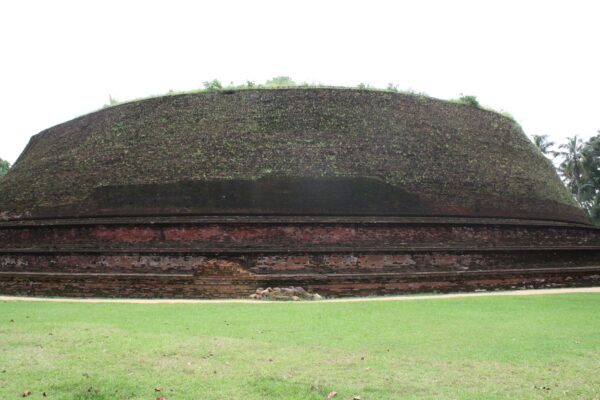Digging into ‘Kota Vehera’ By Somasiri Devendra
(An excerpt from “Jungles, Ruins and Shipwrecks”)

Once, only, did I have the privilege of watching a systematic archaeological excavation in progress. [Note:The excavation was conducted by my father, D.T.Devendra, Asst. Commissioner of Archaeology] It was the excavation of the “Kota Vehera” at Dedigama, the supposed birth spot of Parakramabahu l. Called “Kota” vehera because its upper structure (hataras-kotuwa, devata-kotuwa and kot-kerella) had not been completed, it was really a massive structure. Dagobas are built upwards from far below ground level, in solid brick and stone up to and above the relic chambers. Above that was a rubble, brick-bat and earth filling, with the brickwork outside gradually tapering off the dome. So to get inside one, you entered from above, with no damage done, and dig till you come to the solid brickwork. The serious work begins then. By the time I was allowed in, all that had been done and the brickwork was being removed. It was a mason’s work, in reverse. The workers carefully eased-out individual bricks. Exposing each succeeding layer took time. Each deeper layer was better laid above it. Finally the finely laid layers immediately above the relic chambers came into view and a different set of workers came in; the most experienced ones, working with trowels no larger than spoons. One by one, they removed the bricks above one chamber till they came upon stone. The chamber that, from our perspective, was now a pit, was covered over with granite beams placed side by side, touching each other. Years of pressure from the weight above them, had cracked them, but the pieces had not parted. The trick was to prevent them parting and falling inside. Finding the most intact, several ropes were tied around it and attached to a tripod fitted with a pulley block. With infinite patience the beam was inched from its position, till its full weight was born by the tripod and it was gently swung upwards and sideways and placed elsewhere. The chamber was now visible, but more delicate work remained to be done. The remaining beams were cracked: each cracked piece had to be secured by rope and everyone lifted out at the same time. It was an awesome task but it was finally done. Photographs of every step were taken and the chamber photographed before anyone ventured in. It was a solemn moment to see the chamber after eight centuries. In the middle was the Meru gala, the square stone pillar representing Mount Meru, the Cosmic Mountain. Resting on it was the main reliquary. Around the central pillar and at the corners of the chamber were multi-headed cobras in terra-cotta. Set into niches on the four walls were images of the Buddha made of gold foil filled with sandalwood paste. The walls were covered with a paper-thin plaster painted, but in a manner never before seen in this country – black background with beautiful red line-work figures, classical in simplicity and rendering.
In all, nine chambers were found, eight geometrically disposed around a central one. Later, another, much smaller dagoba was found near the edge of the inner perimeter of the base and that yielded a koraha! But that is another story.
After the excavation of the first chamber, it was carefully roofed over with a canvas canopy and we drove back to Colombo with the specimens for analysis. I don’t remember the journey back: the encounter with the past had been too overwhelming.
Somasiri Devendra







